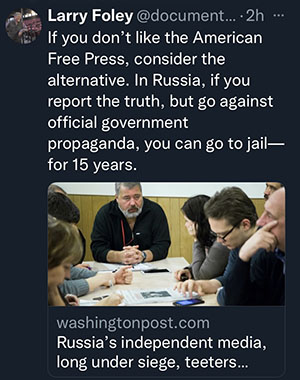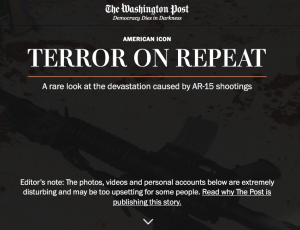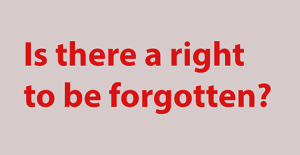7 Media Ethics
By Dave Bostwick
When I was working as a news reporter and later as a faculty adviser for a collegiate student newspaper, I observed a few situations when journalists knew much more than they included in their stories. As an extreme example, I remember a case in which police helicopters were scouring a wooded area beside an apartment complex. They were trying to locate the body parts of a murder victim.
It was a high-profile local case, but the journalists did not publish or broadcast specific details about what police hoped to find. It seemed too gruesome and would have caused extreme emotional harm to the victim’s family.
This incident occurred before social media and our modern-day emphasis on immediate publishing. I don’t know whether that would factor into reporters’ decision-making process in a similar situation today.
In the previous chapter, we studied how laws can be based on ethical principles, but there are some distinctions between media law and media ethics. We’ll open this chapter with a hypothetical situation that furthers that distinction.
Study the following presentation slides by using the forward button or clicking on sections of the control bar. To enlarge any interactive presentation in this book, click on the lower-right full-screen option (arrows).
As you can surmise from this opening hypothetical, ethical decisions are rarely easy for media professionals.
YOUR MEDIA LANDSCAPE
To be an ethical professional in your chosen career, what is the single most important ethical trait you should exhibit on a daily basis?
SPJ CODE OF ETHICS
In journalism, freedom of speech comes with responsibility. That’s why we need ethical guidelines, and a good place to start is the Society of Professional Journalists’ Code of Ethics.
The preamble to the SPJ Code of Ethics says, “The Society declares these four principles as the foundation of ethical journalism and encourages their use in its practice by all people in all media.” Thus, the SPJ Code of Ethics can apply to professionals working in advertising and public relations as well as traditional newsroom journalists.
The following presentation briefly examines the four principles in the SPJ Code of Ethics.

WHY NOT HAVE PROFESSIONAL LICENSES?
Lawyers and certified public accountants earn professional licenses by passing standardized exams. The licenses can raise the stature of the profession. Why not journalists?
While this might seem like a good idea, it would clash with the First Amendment. Everyone, not just journalists, enjoys freedom of speech.
Also, if governmental officials set licensing standards, as would likely be the case, what happens when journalists publish information that reflects poorly on those officials? For example, journalists who report regularly on government corruption might risk losing their licenses for reporting the truth.
ETHICS IN ADVERTISING AND PUBLIC RELATIONS
The SPJ Code of Ethics applies to all media professionals, but ethical concerns can be trickier for those in the fields of advertising and public relations. PR and advertising professionals must be loyal to clients as well as the public. In some situations, telling the entire truth to the public can harm a client’s sales or public image.
Here’s another way to frame this friction. Pick the concept below that better aligns with your personal viewpoint.
- A company exists to generate profit for its owners and/or shareholders.
- A company exists to support and sustain its community and key stakeholders, including employees.
For example, let’s say an energy company wants to increase profit for shareholders by drilling for oil on local land. However, this drilling may negatively impact some local wildlife and detract from tourist-related businesses in the area. Thus, the drilling would harm some community stakeholders who have minimal control over the energy company’s business decisions.
In advertising and public relations, one frequently cited ethical concept, called corporate social responsibility, attempts to reconcile a company’s need for profit with its duty to support and sustain community and stakeholders.
According to the management training video below, “Corporate social responsibility is about balancing profit-making against social and environmental concerns.”
Media professionals increasingly implement corporate social responsibility to promote a positive public image for companies and organizations, even if the organizations are not profit-driven.
Here are additional videos related to corporate social responsibility.
- Corporate Social Responsibility Examples: CSR in Marketing (more explanation)
- Boomers Parks’ Corporate Social Responsibility (small-business example)
- Valley Bank: Inspiring Change – Our Corporate Social Responsibility (small-business example)
And you can watch a staged video from Fenrir Media that illustrates the importance of sincerity in promoting corporate social responsibility. Using today’s digital media platforms, it’s easy to say you promote corporate social responsibility. It’s much harder to remain socially responsible on a daily basis.
REAL ETHICAL DILEMMAS
An ethical dilemma occurs when two ethical principles compete against each other. In these cases, media professionals may not agree on the proper ethical decision.
 For instance, most editors avoid showing bloody photos from mass shootings and wars because they want to minimize harm to the victims’ families, who may not want to see visual reminders of horrific scenes. On the other hand, news outlets occasionally publish a few carefully selected graphic photos because they think it has a meaningful impact on viewers.
For instance, most editors avoid showing bloody photos from mass shootings and wars because they want to minimize harm to the victims’ families, who may not want to see visual reminders of horrific scenes. On the other hand, news outlets occasionally publish a few carefully selected graphic photos because they think it has a meaningful impact on viewers.
In 2023, The Washington Post published “Terror on Repeat: A rare look at the devastation caused by AR-15 shootings,” which included blood-stained classrooms after the 2022 school shooting in Uvalde, Texas. In an explanation to readers, editors wrote that “most Americans have no way to understand the full scope of an AR-15’s destructive power or the extent of the trauma inflicted on victims, survivors and first responders when a shooter uses this weapon on people.”
This is a legitimate ethical dilemma that pits reporting truthfully against minimizing harm.
As another example, journalists have historically debated whether it is ethically acceptable to publish details about politicians’ extramarital affairs. Some argue for truthful reporting because this type of behavior reflects on a politician’s moral fitness for public office. However, others believe this information is not newsworthy and will unnecessarily harm affected family members.
 And as a consequence of internet archiving, people sometimes request that newspapers unpublish stories about minor crimes they committed a decade or more ago. The damaging stories may resurface when, for example, employers conduct a web search about a job candidate. For journalists, the real ethical dilemma pits reporting truthfully (don’t unpublish) against minimizing harm (unpublish).
And as a consequence of internet archiving, people sometimes request that newspapers unpublish stories about minor crimes they committed a decade or more ago. The damaging stories may resurface when, for example, employers conduct a web search about a job candidate. For journalists, the real ethical dilemma pits reporting truthfully (don’t unpublish) against minimizing harm (unpublish).
Also, Poynter reported about some people in vulnerable situations who, fearing retribution from the Trump administration, asked editors to remove their names from old news stories.
FALSE ETHICAL DILEMMAS
A false ethical dilemma implies that there are only two options. When we closely analyze the ethical considerations, though, there may be more options or there may be only one proper choice.
It’s OK to pursue fame, prestige or money as long as that pursuit does not lead to unethical behavior. However, a journalist should not prioritize fame, prestige or money over ethical conduct. This is a false dilemma. Ethical conduct should always be a priority.
For example, a journalism photographer may take pride in winning photography contests. If the photographer manipulates the content of a photo in order to win a contest, though, the photographer has fallen victim to a false ethical dilemma.
The photographer in this example incorrectly perceives two mutually exclusive choices: 1) gain prestige by winning the contest with a manipulated image; or 2) follow ethical codes and lose the contest. In fact, the photographer could follow ethical codes and still win the contest with an engaging, authentic photo.

Similarly, editors who write clickbait headlines prioritize a large audience (and accompanying revenue) over the ethical standard of truthfulness. This is a false ethical dilemma, though, because a catchy but truthful headline can gain a large audience as well. In this case, the clickbait headline can be viewed as an unethical shortcut.
It’s important to note that deceptive, sensationalized news existed centuries before electronic media. In his book The Gutenberg Parenthesis, Jeff Jarvis cited a 16th-century fictional tale in which a tradesman reflects on the profit to be gained from selling content that today we would call fake news. The tradesman offers these lines:
It doesn’t much matter whether the story’s true.
The world wants to be deceived,
they buy lies for good money.
The more outrageous the lie, the better the sales,
as all singers know very well.
CONNECTIONS BETWEEN DIVERSITY AND ETHICS
The following quote comes from the Online News Association’s statement on diversity.
Many journalists see diversity as an issue that overlaps with journalism ethics. It may be a social issue and/or a business issue, but they say it is an ethical issue because failure to reflect the diversity of a community is a matter of accuracy.

Ninette Sosa was a CNN journalist who later became a professor of practice and the director of outreach for the School of Journalism and Strategic Media at the University of Arkansas. In the audio below, she shared her thoughts on the relationship between diversity and ethics.
Here is a script of the audio.
MEDIA ETHICS AND ARTIFICIAL INTELLIGENCE
In the next decade, we’ll no doubt see a parade of AI-related case studies that test ethical boundaries (or trample them). Media companies may be held accountable for mistakes, or untruthful reporting, in AI-generated content. To achieve transparency, media professionals need to apply clear standards for acknowledging when content has been created using AI tools.
Guardian columnist Margaret Sullivan suggested that news journalists “should provide access to full versions of the audio and video that their stories are based on, and should allow people to examine original documents or data sets.”
As an extreme example of unethical AI usage in journalism, Futurism reported that Sports Illustrated “published content from nonexistent writers with AI-generated headshots.”
The investigation concluded that some writers’ headshots and profile photos were fake, and some story content may have been AI-generated as well. The Futurism article included this perspective on media ethics.
Bylines exist for a reason: they give credit where it’s due, and just as importantly, they let readers hold writers accountable. The undisclosed AI content is a direct affront to the fabric of media ethics, in other words, not to mention a perfect recipe for eroding reader trust.
TRUE or FALSE
The following questions highlight a few tidbits of information from the chapter. Use the forward button or click on sections of the control bar to advance through the questions.
APPLYING ETHICAL CODES
Review the opening hypothetical about emails that were illegally hacked but contain important information that citizens should know about their elected mayor.
Now that you’ve read the chapter and become familiar with ethical principles, including the SPJ Code of Ethics, pretend that you are the television reporter.
You have fully verified the information. Would you broadcast what you’ve learned from the emails?
Use content from this chapter, especially the SPJ Code of Ethics, to support your response. Which ethical principles are involved in this case?
Write at least 250 words in journalistic style with approximately three sentences per paragraph.
MORE CODES OF ETHICS AND PRINCIPLES
If you are interested in learning more about professional media ethics, peruse the following websites:
- News Values and Principles – Associated Press
- PRSA Code of Ethics – Public Relations Society of America
- SPJ Code of Ethics – Society of Professional Journalists
- Media Ethics – Purdue OWL

